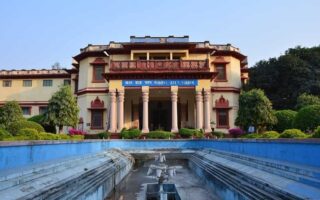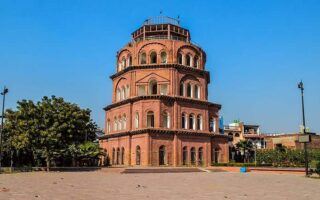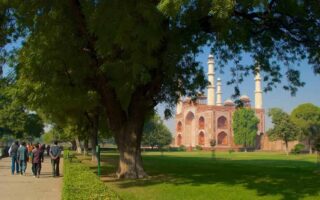Fairs and festivals are an inherent part of Uttar Pradesh; these festivities form an important part of the culture and traditions of the state and are epitomes of the rich cultural heritage. One can see amalgamation of several religions, beliefs, and costumes on these colorful occasions. Festivals of Uttar Pradesh are celebrated with much fanfare and exhibit the thrilling charm of the folk-lore.
Since time immemorial, numerous festivals and fairs have been celebrated with zeal and enthusiasm. The robust culture and age old traditions are reflected in the celebrations. These occasions are made alive with music and dance performances by the artists; the soul stirring festivities reflect the spirit of the state. These attract the tourists from all over the world and offer ample opportunities to take part in such occasions.
Lolark Sasthi Festival
- Celebration Months: August/September
- Religion: Hindu
- Importance: Worship of Sun
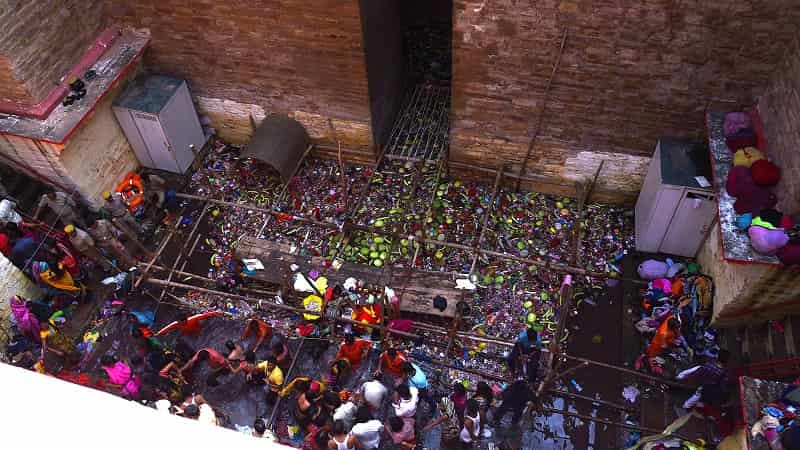
Lolark Sasthi Festival is a popular festival of Varanasi that is celebrated every year on 6th day of the Hindu month Bhadrapad. The festivities take place either in late August or in the beginning of September. Lolark Kund is the venue of the festival. The word “lolark” means trembling sun. As the reflection of the sun wavers in the waters, the term lolark is used for the festival.
A large number of devotees congregate at the place and offer their prayers to the Sun God. The day carries immense religious and cultural importance to the Hindu devotees. On the auspicious occasion of Lolark Shasthi festival, city of Varanasi comes to life and vigour.
Navratri Festival
- Celebration Month: April and October
- Religion: Hindu
- Importance: Worship of Durga

Legend linked with the Festival
Navratri festival is associated with goddess Durga and the killing of the demon Mahishasur. The demon was an ardent devotee of Lord Shiva. Through his arduous worships, he sought the blessing of immortality. Proud of his immense powers, he started harassing sages and other innocent people. Soon he set out to dominate the three “lokas” including the “swargloka”(heaven). The gods of heaven, in order to get rid of Mahishasur, prayed to Lord Shiva. To protect the world for his destructive acts, the three supreme powers, namely, Shiva, Brahma, and Vishnu, joined hands. A powerful female deity was born by their union. This goddess of sheer beauty was called Durga. As Mahishasur saw her, he was floored by her attractive appearance and with the intention of marrying her, approached Durga. The goddess agreed to his proposal but laid down the condition of defeating her in the battle. Ignorant of her powers, the demon fought with her for nine days and with the advent of tenth day, the goddess beheaded him. Navratri is the celebration of the victory of good over evil.
Attractions of the Festival
The goddess is venerated by worship of her idols. In her images, she is shown as a gentle woman, radiating immense powers. She is depicted with ten arms, out of which nine are shown to holding different weapons. And the tenth one holds the decapitated head of Mahishasura. She is shown sitting on a lion, her carrier. In some of the images, her children namely, Kartik, Lakshmi, Saraswati, and Ganesha are also depicted.
These lovely idols are decorated extensively. Their creation is an art in itself; the highly skilled sculptors make the images form material like bamboo and clay. The idols are also adorned with decorative attires and glistening crowns and attractive jewelry. After their decoration is complete, the idols are installed at temples. Enthusiastic devotees collect money months before the actual celebrations begin. They get to arrange puja-pandals where these idols are placed and some of theses pandals are even advertised in order to attract the devotees.
Navratri festival commences from the first day of the Hindu month Ashvin. Some of the devotees observe fast on all the nine days. Others eat special food items that are meant for fasting. People sow the seeds of barley in a pot, the grasses sprout from the seeds and are worshipped by chanting of devotional songs and lighting of scented “aggarbattis”. During the first three days, goddess is worshipped in the form of Durga or Kali, a force that destroys all evil factors form life. The next three days, the goddess is venerated in the form of Lakshmi, the deity of wealth and fortune. The last three days are meant for worshipping her as goddess of wisdom and success, Saraswati. The girls of pre-pubescent are also worshipped.
At puja pandals, one can enjoy a number of cultural activities and relish food items. The glittering ceremony of worship is the main highlight. Most of the pandals are theme-based. Some of the themes are based on ancient civilizations. The event is commercialized through several billboards. Towards the end of the event, the idols are carried in a procession and immersed in water.
The festival of Navratri is symbolic of the victory of good over evil; it motivates us to follow the path of righteousness and morality.
Shivratri
- Celebration Months: February/March
- Religion: Hindu
- Importance: Marriage of Lord Shiva to Parvati
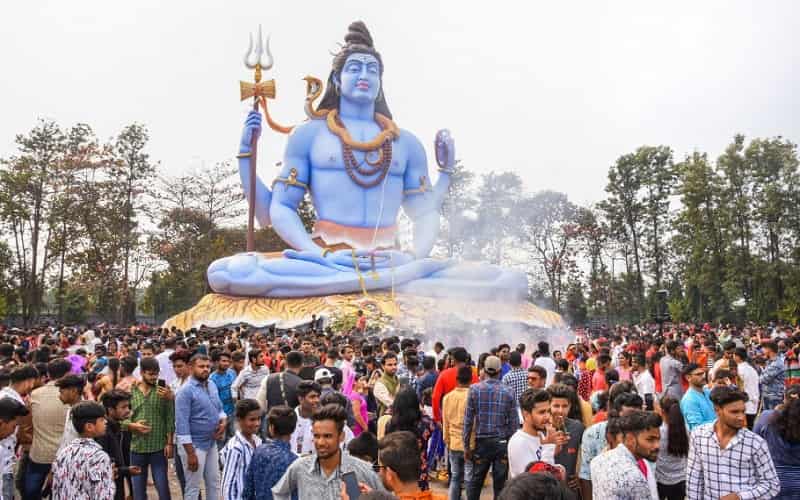
Celebrated in the month of Phalgun, Shivratri is a sacred festival of Hindus. This auspicious occasion carries extreme religious significance to the devotees who take part in the festivities with ardent faith. Marking the culmination of love of Lord Shiva with his consort Parvati, this festival celebrates the marriage of these deities. The festivities take place during waning moon or Krishna Paksha of the Hindu month Maagha or Phalgun.
Attractions of the Festivities
During Shivratri, the devotees observe fast and spend the entire day without food or water. The celebrations take place at night when Shiva lingam, the sacred phallus of Lord Shiva is worshipped with ardent faith. The lingam is washed after every 3hours; it is bathed with rose water and is offered items like honey, milk, curd, ghee, and sugar (collectively they are called Panchamrita). The devotees adorn their foreheads with three stripes of “bhabhuti” or holy ash; these stripes symbolize three eyes of the Lord and stand for penance, wisdom and purity.
Legend Associated with the Festival
Bhishma, a character from Mahabharata, while lying on a bed made of arrows told the story of Chitrabhanu. According to this story, Chitrabhanu who was a ruler of Ikshvaku dynasty had observed a fat on the auspicious occasion of Shivratri. A saint visited his court and asked about the reason behind the fast. As the king was blessed to remember his last birth, he told the sage the happenings of his previous life. According to his description, he was a hunter that used to earn his livelihood by killing and selling animals. One day, as he was roaming in search of a hunt, he lost his way due to the darkness and took shelter at the top of a bael tree. He was already carrying a deer that was killed by him during the day time. As he was unable to carry it, he tethered with the branch of the tree. As he was relaxing, the thoughts of his family bought tears to his eyes; in order to pass time, he started plucking leaves of the tree and started throwing it on ground. As the night passed, and he reached home, a saint stepped in and asked for some food. Chitrabhanu, who had kept fast the earlier day, fed the sage with food that he had bought for his family.
Chitrabhanu further told that at the time of his death, he was visited by the messengers of Shiva. They told him that he had earned a lot of blessing by performing unconscious worship of the Lord. He was told that a lingam was situated at the bottom of that tree at the top of which he was resting. The water shed in the form of tears washed the lingam and absolved his sins. The leaves of bael tree served as an offering to the lingam. Besides this, as he had fasted all day, he had, in fact, worshipped the Lord unconsciously.
The zest and devotion of people at the time of Shivratri is worth watching. The festival reflects the inherent faith installed in their hearts in reverence to their deities.
- Also Read: Most Popular Shiva Temples in India
Vasant Panchami
- Celebration Months: January/February
- Religion: Hindu
- Importance: Advent of spring season
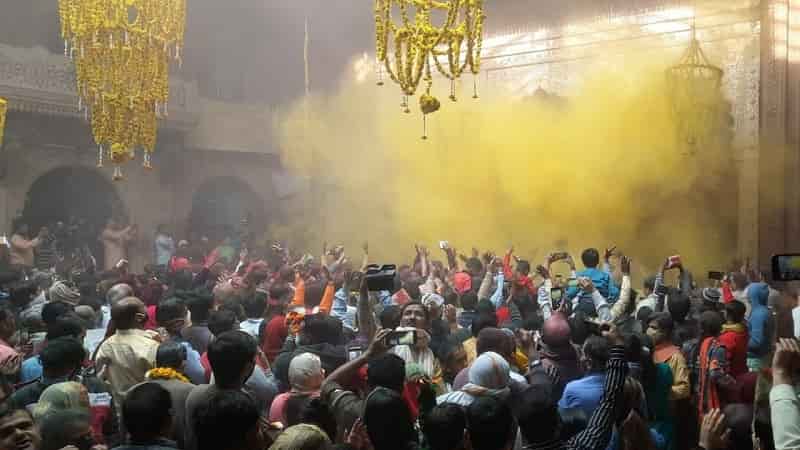
Commonly called by the name Magh Shukla Panchami, the festival of Vasant Panchami is celebrated to mark the beginning of spring season. This colorful festival is enjoyed thoroughly by people; coupled with joy and gaiety, the festival is a welcoming break from the chill of the winter season.
During Vasant Panchami, one notices the cheerful arrival of spring when the entire environment is filled with scent of blooming flowers and melodious songs of chirping birds. People wear yellow clothes on this day which symbolizes the spirit of spring season. Everyone gets dressed in shades of yellows, wear yellow tilak on foreheads, and use handkerchiefs of the same color. Even the dish called Kesar halwa is yellowish in color. This particular color reflects nature’s spirit during this season. The youngsters indulge themselves in merry-making.
At some places, the festivities of Vasant Panchami are accompanied by beating of drums which is a gesture to welcome the festival. In Rishikesh, a special fair is organized at Bharat Temple; the idol of the deity is carried in a procession and finally placed at the temple. Worshipping Goddess Saraswati is the main feature of the festive celebrations. The image of the deity is taken out in a procession and then immersed in River Ganga. Other special events that mark this auspicious festival include feeding of Brahmanas and worship of ancestors (Pitru – Tarpan). The worshippers get up early in the morning and offer prayers to sun and River Ganges.
Legend Associated with the Festival
As per a legend, Lord Shiva was, once, meditating in order to beget a son who was supposed to kill the demon Tarakasura. As he was deeply absorbed in Samadhi, cupid (God of love) threw an arrow to disturb him. Shiva got so angry with cupid that his third eye was opened and cupid was burnt to ashes.
Vasant Panchami is a festival of gay and mirth that offers a break from the monotonous life.
Diwali Festival
- Celebration Months: October/November
- Religion: Hindu
- Importance: Symbolizing the triumph of good over evil and the victory of light over darkness.
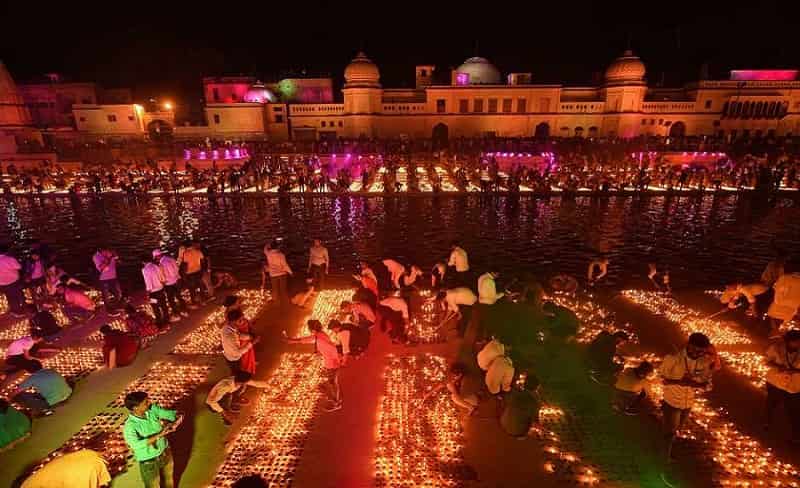
Celebrated in the month of Ashwin, Diwali is the sacred festival of Hindus. The festival of paramount religious significance and marks the victory of good over evil. It symbolizes the light and wisdom; it is considered that one should always strive to overcome darkness and try to enlighten the souls with knowledge of truth and goodness. Diwali festival is celebrated with ardent zeal in Uttar Pradesh.
Origin of the Festival
According to the holy book of Hindus, Ramayana, Lord Rama, after spending 14 rigorous years in jungles, returned to Ayodhya. While in exile, he along with his brother Lakshman and wife Sita spent a long time in jungles; during their stay, Deity Sit was abducted by the demon king of Sri Lanka, namely Ravana. Rama after killing this demon, returned back to his kingdom. The people of Ayodhya welcomed them by burning oil-lamps. Since then Diwali festival is celebrated to commemorate the victory of good over evil. It is also believed that departed souls visit the houses of their kith and kin. In order to guide these souls to go back, houses are lit with lamps.
Attractions of the Festival
At Varanasi, thousand of devotees light earthen lamps which are left over the water surface. Devotees from different parts of India throng here to watch the captivating view. Celebrations of Diwali are done on a grand scale. People clean their houses with white wash; people start making preparation many days before the event. People decorate their houses with leaves of mango and people, the rooms are decorated with colorful confetti and other colorful items. The courtyards are adorned with beautiful patterns of Rangolis. In addition, auspicious motifs are used to ward off evils.
The most prominent feature of diwali festival is the firing of crackers at nights. The noisy pitch of the crackers fills the entire atmosphere. People use artificial lights to lit their houses; the entire scene looks spectacular. Special religious ceremonies are organized at festivals, Hindu devotes perform massive puja celebration to pay their reverences to Goddess Lakshmi whose blessings are supposed to bring wealth and prosperity to the worshippers. The other deities that are worshipped are Lord Vishnu (bestower of wishes), Lord Ganesha (hurdle remover), and Lord Indra (symbol of power). On next day, women worshippers beat bamboo baskets; it signifies the arrival of goddess Lakshmi in their houses and removal of poverty.
Another important event that marks the celebration is preparing special sweets and distributing them among relatives and friends. Diwali Festival in Uttar Pradesh is also character sized by enacting the roles of Lord Rama, Lakshman, and Sita by the Brahmin boys; these boys are trained by their leader called liladhari.
This festival is celebrated with ardent faith and enthusiasm of Hindus and reflects their religious sentiments towards their revered deities.
Hanuman Jayanti
- Celebration Months: March/April
- Religion: Hindu
- Importance: Worship of Lord Hanuman
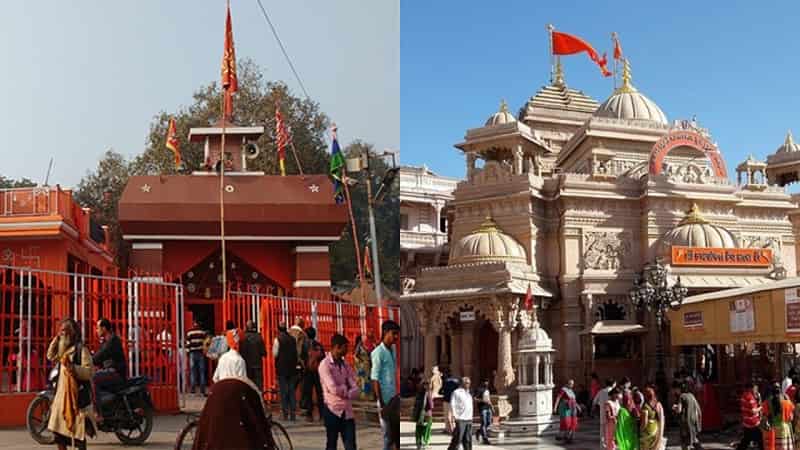
Hanuman Jayanti is one of the holiest festivals of Varanasi. Located on the banks of Ganges, Varanasi is itself a sacred city and is highly revered by Hindus. Being the venue of several auspicious occasions, the place holds a prominent place in their hearts. Celebrated in the honor of Lord Hanuman, this special festival is marked by several rites and rituals.
Lord Hanuman was a staunch devotee of Lord Rama and dedicated his entire life in the service of his master. He helped Rama in rescuing his beloved wife Sita from demon Ravana. He is considered on of the avatars of Shiva and a great Yogi who lived the life of Brahmacharya (chastity) and worked relentlessly in the service of others. On the occasion of Hanuman Jayanti, followers worship Lord Hanuman; his ardent faith in Rama and his unparallel devotion to him are the main reasons behind hi worship. The day is celebrated on a grand scale on Shukla Poornima of the month Chaitra.
Attractions of the Day
The day celebrates the birthday of Hanuman or the monkey god, as he is generally called. The Lord is venerated by millions of Hindus. The day carries paramount importance for those who live the life of celibacy. This significant day is marked by bathing of the idol by the priests and offering prayers to it. The idol is adorned with Sindoor (vermillion) and oil which are considered as symbols of life.
Legend linked with vermillion: It is said that once Sita was applying vermillion on her hair; when asked by Hanuman the reason for doing so, she replied that Sindoor will ensure a long life of her husband; longer the Sindoor she wears , longer will be his life. Hearing this, Hanuman applied vermillion on his whole body so that his lord becomes immortal. This is the reason behind application of Sindoor over his idol.
On Hanuman Jayanti, devotees make offerings of bananas and fruits so as to please the monkey god. As a token of veneration, monkeys from nearby areas are also worshipped in this significant occasion. People observe fast on this day. North Indian states like Uttar Pradesh and Bihar celebrate it with enthusiasm and fanfare. At some places, huge tents are erected at temple premises; people throng to these places in order to listen the sacred chants from “Hanuman Chalisa”. A grand procession is taken out in which people dance to the beats of drums.
The festival is characterized by several cultural programs that are organized on this day. “Nautanki” dramas of Uttar Pradesh enact the life of Lord Hanuman and showcase his sheer devotion to Rama and stories of his mighty strength. It is a special event for bodybuilders and weightlifters that get an inspiration from him. A number of competitions like wrestling, body building etc, are organized. As the competitors start the fight, chanting of “Jai Hanuman” fill the atmosphere. The winners are rewarded hugely; a number of other games like pulling heavy vehicles with teeth, balancing a huge stone on chest, and other competitions that are centered on showcasing one’s body strength are the main attractions of Hanuman Jayanti. Some of the wrestlers observe a fast on this day; this is done as a token of respect and devotion to Lord Hanuman.
Legend associated with Lord Hanuman: A plenty of stories are linked with this divine God. Apsara Anjana, mother of Hanuman, caught the attention of Vayu God by her peerless beauty. Their love culminated in the form of child Hanuman. AS he was born, he was so hungry that his mother’s milk was not able to settle down his insatiable hunger. In order to satisfy him, he flew in the sky to eat sun. Enraged by his act, Indra initiated a thunderstorm to stop him. This injured his chin. He was taken to a shelter by Vayu. The child Hanuman was visited by several gods who blessed him with immense strength and invincible powers. As his chin became swollen, he came to be known as Hanuman or “large jaw”.
Lord Hanuman is a symbol of life and strength. He is revered by million of devotees and Hanuman Jayanti is an epitome of his selfless love and miraculous efforts.
Kartik Poornima Festival
- Celebration Months: November/December
- Religion: Hindu
- Importance: Lighting Earthen Lamps
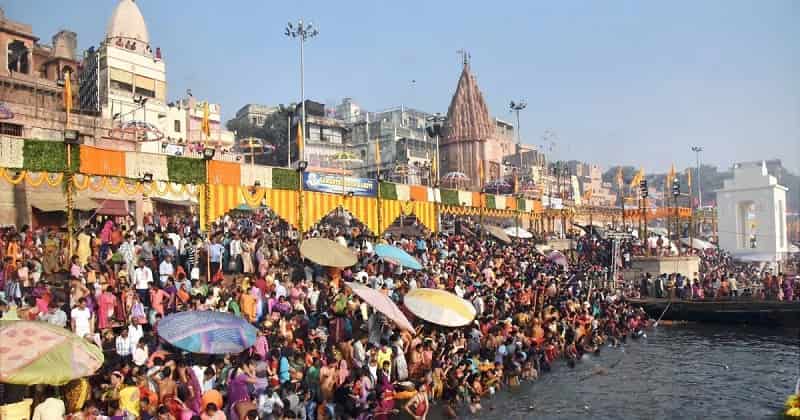
Kartik Poornima festival, or Dev Deepawali as it is commonly called, is a sacred festival of Hindus that is celebrated each year in the months of November and December. This special festival is celebrated on the banks of Ganga River in Varanasi when thousands of earthen lamps are lit and holy tributes are paid to the mighty river.
Attractions of the Festival
It is believed that Gods visit the earth on this auspicious occasion. Also called by the name of Ganga Mahotsav, Kartik Poornima festival is among the holiest festivities of Uttar Pradesh. During the month of Kartik Poornima, devotees avoid taking non-vegetarian diet. Baths are taken before dawn and later temples are visited. The last week of the month is considered most sacred. The period is known by the name of “Panchaka”, the last day of which is termed Kartik Poornima. During this period devotees eat food only once in afternoon; the food is called “Habisha”.
Panchaka: Celebrated for five days, most prominent feature of Panchaka is the holy bath which is taken just before dawn. Women folk make color powders at home and make floral designs around a small temple called Chaura. A plant of basil (Tulsi) is planted in this temple-like structure and is worshipped with full devotion. People observe fast on these five days and visit Shiva temples. It is believed that Lord Shiva had killed the demon named Tripurasura on this day. At temples, kirtans are organized for the whole day; this is accompanied by the playing music on instruments like mridangam and cymbals.
Full Moon Day: On 15th day of the Hindu month Kartika, on Shukla Paksha, full moon celebrations take place. During this time of Kartik Poornima festival, moon rests in the Aries zodiac. The full moon at this time is period of celebration of Dev Deepawali. This special occasion of Tripuri Poornima is marked by the worship of Lord Shiva. Celebrated on the next day of Shivratri, Deepdan is the major attraction on this day. A number if rites and rituals are observed. After doing Kartik Snan (Holy Bath), devotees lit a number of Diyas or earthen lamps on the banks of river. This is followed by “arti” that is dedicated to River Ganges. Chanting sound of mantras and prayers can be heard at the venue. The visitors can have a glimpse of the golden feet and hands of deities Balram Dev, Jagannath Dev, and Subhadra Devi.
On Dev Deepawali, one can also get to have a glimpse of the cultural heritage of the city. The celebrations are held on Dasaswamedha Ghat on Prabodhini Ekadashi. Talented artists that excel in their fields give beautiful performances. Kartik Poornima festival welcomes a number of pilgrims who come here to pay their homage to the holy river. As thousands of lamps are set ablaze, the entire sight becomes spectacular.
Legend Associated with the Festival
Demon Taraka had three sons named as Tarakaksha, Vidyunmali, and Kamalaksha. These sons had worshipped Brahma and won his blessings. Lord Brahma had awarded the gift of immorality for thousand years along with the condition that they will be killed only when a single arrow that merges the three cities will be fired at them. These three cities were collectively called Tripuri and were built of iron, sliver, and gold respectively.
Kartik Poornima festival is celebrated with devotion and is one of the most sacred festivals of the state.
Lucknow Festival
- Celebration Months: November/December
- Religion: Hindu
- Importance: An art and craft fair
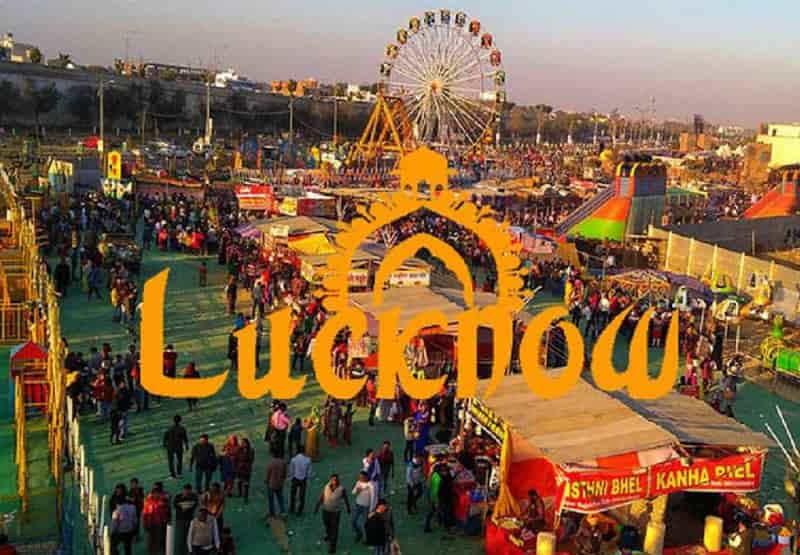
Lucknow Festival of Uttar Pradesh is a showcase of the rich cultural heritage of the state that has been its part since ages. The festival is an embodiment of the splendid elegance of Awadh. It involves brilliant display of art, craft, and culture of the state. In fact, the festival is the reflection of the colorful and lively spirit that has been the part of the Lucknow’s splendor.
The festival helps one to explore the old traditions and vibrant art in the form of music, dance, paintings, and works of crafts. Attending the festivities can be one of the most memorable experiences. One can also enjoy the delectable delicacies consisting of delicious dishes. Lucknow Festival is celebrated between November 25 and December 5. The celebrations that are attached over a time span of ten days are really captivating and reflect the grandeur of the old city. The main attractions of the festival include Kathak Dances, traditional drama, decorative processions etc. In addition, the breathtaking performances by Lucknow Gharana, mesmerizing recitals on musical instruments like sitar and sarangi, melodious Ghazals and Qawwalis are the highlight of this special occasion.
In order to create the nostalgia of the bygone era, several competitions like Ekka races, cock fighting, and other traditional games are organized. These are participated by thousands of people who take part in these exciting events with zeal and enthusiasm. A vast display of antique pieces that were used in the period of nabobs is worth admiration.
Lucknow Festival is the celebration of grandeur of the culturally rich state.
- Also Read: Best Things To See & Do In Lucknow
Raksha Bandhan
- Celebration Months: August/September
- Religion: Hindu
- Importance: Celebration of love of brother and sister
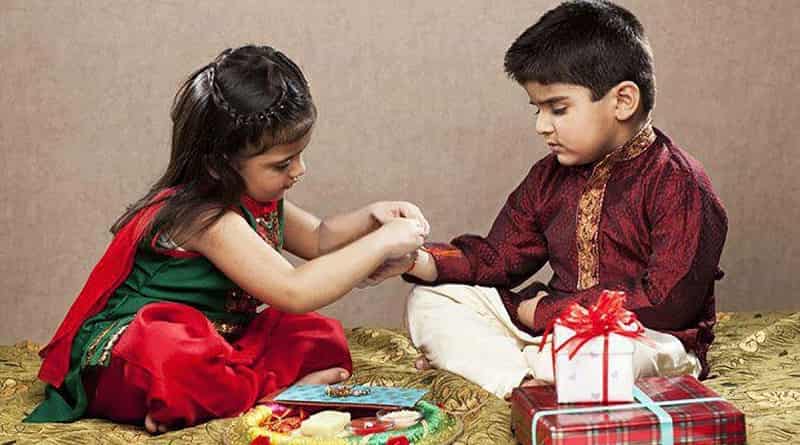
A festival of North India, Raksha Bandhan is a festival that celebrates love of brother and sister. The festival is not only popular among Hindus; Muslims and Sikhs also celebrate it with enthusiasm. It is a symbol of bond between sisters and brothers. Sisters tie a thread or rakhi on the wrist of their brothers; both pray for each other’s well being; the brother promises to protect her sister at the time of need.
The word “Raksha Bandhan” means a thread of protection. Celebrated on Shravan Poornima, this festival is considered auspicious. It is not only limited to the relationship of siblings, a wife can also tie thread on her husband’s wrist. The thread carries a huge significance; it, in fact, glorifies the bond, warmth and affection of a relation. Some people tie Rakhi to their friends and neighbours also. This auspicious occasion involves practicing cultural ad moral values. Its significance is clear form the fact that brothers try his best to visit their sisters, no matter what the situation is or how busy their life is.
Historical and Religious Significance
According to a legend, goddess Santoshi (an incarnation of Parvati), was created on this day. It is said that Lord Ganesha, on the occasion of Raksha Bandhan paid a visit to his sister. Seeing this, his two sons started pressing him for a sister. It was then that the goddess Santoshi was created form flames.
The epic of Mahabharata has a tale related to this festival. Draupadi, wife of Pandavas, once ties a piece of her sari around the wrist of Lord Krishna as he was bleeding out of an injury. Seeking it as a noble gesture, he declared her as his sister and promised to protect her at the time of need. After several years, when Duryodhana, one of the Kaurava brothers, tried to rip her of her clothes, it was Krishna who came to protect her and due to his divine intervention, she was able to save her honor.
Another tale is related to the famous battle between Alexander and Porus. As they were on a war, wife of Alexander, namely Roxana, sent a thread and requested Porus to restrain himself form attacking her husband in the battlefield. Porus obliged her and did no attack Alexander. The narrative of Rani Karnavati is also very famous. It is said that when Bahadur Shah, the Emperor of Gujarat, attacked Chittor, then the widowed Karnavati, sent a sacred thread to Mughal Emperor Humayun and asked for protection, as soon as Humayun received the thread, he set off to reach Chittorgarh. But as he arrived too late, Karnavati, along with her female companions had already dome suicide.
The famous Rakhi Utsav was initiated by Rabindranath Tagore in order to encourage unity among various communities. Raksha Bandhan is a sacred festival that carries significance even in today’s perspective.
Taj Mahotsav
- Celebration Months: Mid February
- Religion: Hindu
- Importance: Art and Craft display

Organized by the Tourism Department of Uttar Pradesh, Taj Mahotsav is the colorful display of the splendid heritage of the state. Celebrated in Agra’s Shilpgram, the festive occasion is stretched over ten days and is a befitting tribute of the extraordinary skills of artists and craftsmen who get an excellent opportunity to showcase their talent. The fair is attended by exponents of music, dance and craft.
If one wants to have a glimpse into the magnificent culture and traditions of the state, no option can be more appealing than Taj Mahotsav. The festivities are organized every year from February 18 to February 27 and the spectacular celebrations that are involved in it attract thousand of art-lovers form all over world.
Major Attractions of the Festival
The most prominent attraction of Taj Mahotsav includes the breathtaking performances by the musicians, artisans, dancers, and playwrights who congregate at the venue to display best of their arts. The celebrations are the combination of excellent performances by artist belonging to different communities, regions, and states. For example, Sapera Dance of Rajasthan, Kerela’s Kathakali, and Maharashtra’s Lavani can be enjoyed here. In fact, the festival is the amalgamation of folk dances and music from all over India.
Shopping here can be a rejuvenating experience. One can buy items of handicraft, wood carvings, embellished antiques, metal ware etc. In addition, Chikan work from Lucknow, silk saris of Moradabad, and marble inlays from Saharanpur are worth buying.
Taj Mahotsav is also famous for the delectable cuisines including the specialties of the state. One can relish Mughal cuisines that have been popular among tourist. The non vegetarian delicacies of Agra and Lucknow are available for letting the taste buds enjoy different tastes. The festival also offers delightful cuisines for vegetarians. This food festival offers opportunities to the visitors to enjoy the exotic dishes that are prepared by the exponents of cooking.
Accommodation Facilities
A number of government accommodations are available that can be booked by the visitors. One can stay at Tourist Bungalow at Raja ki Mandi, Taj Khema near Taj Mahal, Gulistan Complex at Fatehpur Sikri, and Youth Hostel at Sanjay Place.
Visit to Taj Mahotsav can be one of the memorable experiences of one’s life.
Ganga Festival
- Celebration Months: Months of October and November
- Religion: Hindu
- Importance: Worship of Ganges River
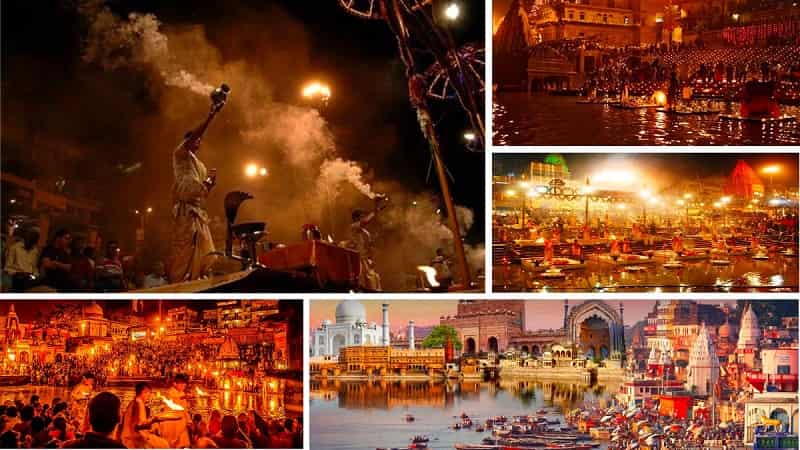
An important occasion for people of Varanasi, Ganga Festival is celebrated every year on the banks of the sacred Hindu River called Ganges. The river is of paramount importance and relevance to Indians who worship it in many ways. The river forms integral part of the lives of those who live on its banks. Since time immemorial, Ganges has been considered a holy water body and its status is considered equivalent to Hindu deities.
Celebrated on full moon in the month of Kartik, Ganga festival is believed to be the day when deities descent for heaven to earth in order to bath in this extremely pious river. The festival is celebrated by burning “Diyas” or the earthen lamps on the banks of the river. As the entire atmosphere reverberates with the chanting of hymns, one feels the spiritual aura taking over him. The mystic look of thousands of people tasking a holy dip, in the sacred waters in wee hours reflects the inherent belief of devotees in the sanctity of Ganges.
A number of cultural programs are organized on this special day; people take part in competitions of marital arts and boat races. The banks are occupied by thousands of people belonging to different caste, creed and communities. Dance and music are the inherent part of Ganga festival. The place has earned the distinction of being visited by a number of music exponents like Bhimsen Joshi, Bismillah Kahn, Amjad Ali Khan, Zakir Hussein, and Bal Murli Krishnan whose breathtaking performances add charm to the festivities.
The festival is important form the religious and cultural point of view to Hindus who take part in the festival with full zeal and faith.
Holi Festival
- Celebration Months: February/March
- Religion: Hindu
- Importance: End of Holika by Prahlad
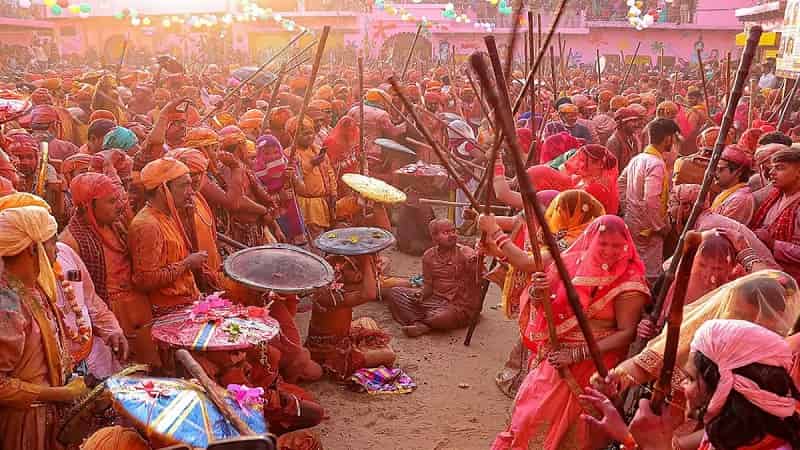
Holi Festival is a colorful festival that is celebrated with great zeal and merriment. This festivity adds the happiness and enthusiasm in the monotonous lives of people. Associated with immense cultural and religious importance, this auspicious occasion has been celebrated in India from centuries. This festival marks the end of winter season and advent of spring.
Legend Associated with the Festival
There are a number of legends that have been linked to this festive occasion. According to one of them, Prahlad, the son of Hiranyakashyap, was a staunch follower of Lord Narayana. Hiranyakashyap was so upset with his devotion that he ordered his sister Holika to take the child in her lap and sit amidst burning flames. As Holika was blessed that she cannot be killed even by fire, she obliged the orders of brother. But due to the blessings of Narayana, Prahlad was saved while Holika burned in the flames.
Attractions of the Festival
Holi Festival celebrations are carried over for two days. The first day marks “Holika Dahan” i.e. burning of Holika. People enact the event by piling the logs of wood and burn them. People throw seeds of barley in the flames. As the fire gets extinguished, these seeds are consumed by people. Depending upon the condition of theses seeds after burning in fir, people make predictions about the harvest in the coming season. As the ashes that are left behind are considered auspicious, they are taken to homes; the ashes are supposed to protect them from diseases.
The second day is marked with splashing of water and various colors on each other. People, weather rich or poor, take part in this colorful celebration. People immerse each other in various colors. The roads get drenched with water and the atmosphere becomes fragrant with the smell of these lovely colors. Friends, relatives, acquaintances gather on streets and throw colors on one another. Even the strangers are not spared. The festival is particularly special for children who love to play in colors and throw balloons of water; their enthusiasm and merriment is worth watching. Colored waters are also prepared using flowers of Tesu. The flowers of this plant are plucked and dried in sun. Later they are mixed with water; this makes the flowers to impart yellow colors to water.
Holi is a festival of merriment and joy that gives a break from the monotonous daily life.
Holi Festival celebration is never complete without Bhang, an intoxicating drink. Consumption of Bhang is inherent in the celebration if this festival. This drink is usually taken in the form of “ladoos” or “thandai”. People usually get high on it and engage themselves in drunken revelries. The city of Varanasi is famous for bhang consumptions. After getting drenched in colors, they sit over the ghats and consume a great deal of the drink. Often this drink is mixed with milk and dry fruits are added for taste enhancement.
This festival teaches people the lesson of “let bygones be bygones”. On this day, people meet each other with love and forget their old enmities. The food preparations are done many days before Holi. Food items like Gujia, Kanji, Papad, Malpuas, Puran Poli, Dahi-Vada, and Mathri are prepared and served to the guests.
- Must Read: Famous Historical Monuments in Uttar Pradesh
Makar Sankranti
- Celebration Months: December/January
- Religion: Hindu
- Importance: Sun’s direction changes to north direction
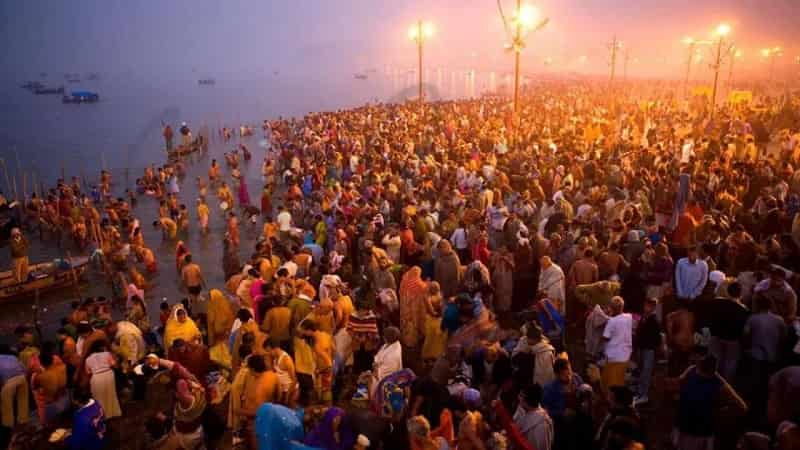
Makar Sankranti is a festival that celebrates the harvest season and is marked by the entrance of sun in the zodiac Capricorn. The festival is organized when sun’s position changes form Karka Sankranti (Cancer) to Makar Sankranti (Capricorn). The day is celebrated every year on January 14.
The festival of Makar Sankranti is called by different names such as Pongal in Tamil Nadu, Uttarayan in Gujarat, Maghi in Haryana and Punjab, and Magh Bihu in Assam.
Traditions and Rituals Related to the Festival
The festival carries immense cultural, religious as well as spiritual significance to Hindus who celebrate it with several rites and rituals. Being the festival that is an embodiment of wisdom, light, peace, and happiness, Makar Sankranti is the manifestation of the fact that after a period of sorrow and grief, happiness and joy take their place, this cycle continues forever.
The festivities are marked by joyous celebrations that are characterized by music and dance revelries. The villagers sweep their courtyard and cover then with cow dung. The floors are then adorned with a number of designs. Sometimes, cow dung is decorated with bright yellowish flowers of pumpkin. It is during this time that people take a holy dip in the sacred Ganges River. Sacred dips are also made in the waters of Yamuna, Krishna, Godavari, and Kaveri.
Makar Sankranti celebrations also involve making offerings of several kinds. People donate extensively and earn the blessings of God by indulging themselves in the sacred activities. Among the offerings that are most common include sesame seeds, jaggery, clothing, vessels, and numerous types of food items.
Ceremony of Haldi-Kumkum: Married women take part in a special ceremony consisting of Haldi and Kumkum. It is considered an auspicious ceremony that is supposed to generate the hidden powers of Adi-Shakti in this materialistic universe. It is believed that the ceremony helps in invoking spiritual awakenings in human beings. Application of Haldi and Kumkum to married women is considered auspicious. In addition, perfume is also applied so that its fragrance pleases the revered deity. Rose water is also sprinkled over married women which invokes the spiritual waves of the goddesses. These women offer each other a gift which is tied to their saris. This is done so that they overcome the body awareness. The gifts that women usually choose include sesame seeds and mud pots. The offerings are supposed to absolve all the worldly sins. Goddess Saraswati is also worshipped at Makar Sankranti. Some people also make offerings to animals like cow, birds, fish etc.
The festival is immensely important in Uttar Pradesh where devotees gather on the holy sites of Hardwar, Varanasi, and Allahabad. Congregation of millions takes dip at these sites. Another inevitable part of the festival involves flying of kites. Brahmans make oblation to their dead ancestors. The fair that is organized at the confluence of three rivers is called Magh Mela. Rites and rituals are observed here with full devotion and faith.
The day before the festival is called Bhogi, on this occasion, people discard old and worn out items form their houses. The roads are cleaned and decorative designs are made on them. A number of sweets, puddings and other food items are prepared on this special day.
Legends linked with the Festival
Makar Sankranti is considered to be the day for angels while Dakshinayana is believed to be their night. It is because of this reason that most of the beginning are made on this day. According to myths, Lord Vishnu killed demons and buried their heads under Mandara Parvata on this day. It is also said that Bhagirath liberated his ancestors from the curse by offering “Tarpan” to Ganges.
Makar Sankranti is a festival of enlightenment and spiritual awakening that encourages man to uplift his soul beyond his body and make offerings to take the blessings of deities.
Ramlila
- Celebration Months: September/October
- Religion: Hindu
- Importance: Victory of Lord Rama over Ravana
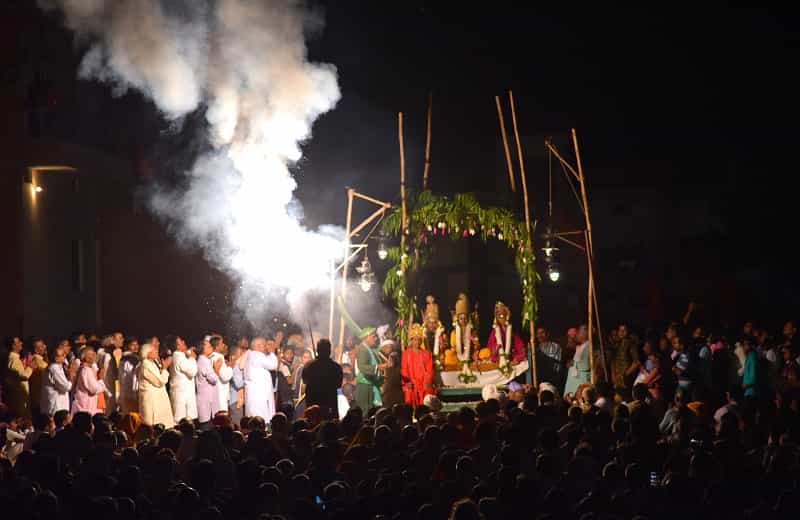
Ramlila is the enactment of the incidents that took place in the life of Lord Rama. The roots of this auspicious festival can be found in the famous epic “Ramcharitmanas” written by saint Tulsidas. The live performances by people leave a lasting impression on the minds of people who throng to the venues in order to watch the enactment.
Ramlila in Uttar Pradesh is celebrated over a period stretching for seven days to a month. As the festival carries religious significance for Hindus, people take part in the festivities with full enthusiasm. Deities like Rama and Sita hold a special place in their hearts; hence they consider it ominous to enact the part of their sacred Gods. It is also lets artist to display their skills in designing costumes, jewelry, masks, decoration, and make-up.
Important incidents from the life of Rama including his birth, his marriage to Sita, going to exile, meeting Hanuman, abduction of Sita, and finally killing of Ravana at his hands are played at Ramlila. The play attracts thousand of zealous viewers whose enchanting voices fill the entire atmosphere. The religious fervor of these devotees is at its full peak and as the story of their lord is manifested through the play, they get too excited.
Usually the play ends on ninth day and the tenth day which is generally called “Vijayadashami” marks the burning of effigies. The players in their costumes are made to sit in tableaux and the procession is carried out on streets. The procession ends at the venue where effigies of Ravana, Kumbhkaran, and Meghnath have been erected. These effigies are filled with a number of crackers. A person who enacts the part of Rama throws his arrows towards the effigies so that they get burned.
Celebration at Several Places
Chitrakoot: Here Ramlila is celebrated for 5 days. It is believed that Lord manifests himself in the person who plays the role of Rama. The celebrations coincide with another important festival called Maha Shivratri.
Ayodhya: Being the birth place of Lord Rama, the place is revered by Hindu devotees. Main characteristic of the festival is that all the performances are based on dialogue and the enactment takes place on an elevated platform.
The festival plays an important part in the life of Hindu devotees who get inspired from the magnificent saga of their revered deity.
Teej
- Celebration Months: August
- Religion: Hindu
- Importance: Union of Shiva and Parvati
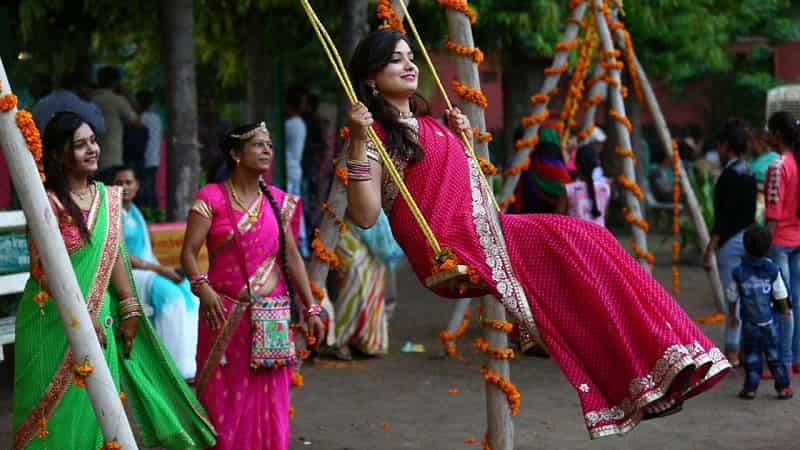
Teej is a festival that is meant exclusively for women-folk and is celebrated the marital bless of the goddess Parvati. The celebrations continue for three days and are accompanied with feasting and fasting. The festivities are observed in several states of India; it is of special significance for people of North India.
Attractions of the Festival
On the occasion of Teej, married women and in married girls put Mehendi on their hands. They adorn themselves by wearing bangles, ornaments and other accessories. They get themselves in beautiful attires. Some of the communities celebrate it by organizing a special lunch that is meant exclusively for women. As per customs, the mother-in-law’s gift jewelry to their daughter-in law.
The married women visit their parents’ house on this particular day and spend some time over there. She carries sweets and other gifts with her. Another important feature that characterizes Teej is hanging of swings on branches of trees; these swings are decorated excessively and women folk enjoy the rides. The festival marks advent of rainy season. At some places women also observe a fast on this day. As the festival celebrates the sacred union of Shiva and Parvati, women sing marriage songs. In Vrindavan, a number of devotees gather at Banke Bihari temple and offer prayers to Krishna and his consort Radha.
Kajari Teej is prominent in state of Uttar Pradesh; prayers are offered to neem tree. It is popular in rural areas. Women observe fast in order to get a happy marital life. Unmarried girls fast to get a good husband.
- Also Read: Most Popular Colorful Festivals of India
